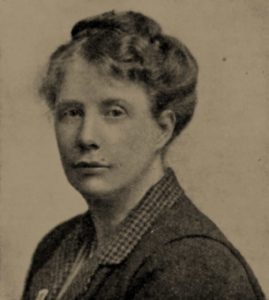
Mary Macarthur (1918)
Born in Glasgow, in 1880, Mary became the bookkeeper for the family drapery business and, at her father’s suggestion, attended a meeting of the Ayr branch of the Shop Assistants’ Union. Mary became converted to the cause after hearing how badly shop workers were treated by their employers.
She became secretary of the union’s Ayr branch and at a socialist meeting met her future husband Will Anderson, an active member of the Independent Labour Party. In 1902, Margaret Bondfleld, a member of the Shop Assistants’ Union who would later become the first woman Cabinet minister, described Mary’s leadership potential as something ‘attaining to genius’.
By 1903, Mary had become secretary of The Women’s Trade Union League. Mary’s biographer Mary Agnes Hamilton wrote: ‘If they were not sure at first that they wanted so powerful a blast through their organisation, they were soon to be conquered both by results and by the sun behind the storm.’
‘There is nothing in the world like believing in a cause and working for it,’ said Mary who soon turned her attention to the plight of Britain’s sweated industries. She was a founding member of the Anti-Sweating League in 1906.
In 1906 she founded the National Federation of Women Workers (NFWW) which, she claimed, ‘organised more women, fought more strikes and did more to establish women trade unionists than any other organisation’.
The women chainmakers’ strike was arguably Mary’s finest achievement. She would go on picket duty before daybreak and remain there long after midnight. Masterful in discussion, she knew how to pitch her cause to different audiences – and the chainmakers’ strike demonstrated her universal appeal, attracting supporters from the aristocracy through to the Conservative press and middle classes.
J. J. Mallon, secretary of the Anti-Sweating League, said of Mary: ‘Breathlessness is her dominant characteristic. She is always at top speed. She whirls from meeting to meeting, strike to strike, congress to congress: the street shouting behind the dust and rattle of her car.’
Not surprisingly, her sense of social justice took her into politics. Mary was close friends with both the Labour pioneer Keir Hardie and with Ramsay MacDonald.
In the 1918 General Election, the first at which women could stand for Parliament, Mary stood for Labour at Stourbridge, but came second to the Liberal candidate by 1,333 votes.
Mary was active in the campaign to establish the International Labour Organisation (ILO), set up as a League of Nations agency in 1919 by the Treaty of Versailles which ended the First World War. She was a women’s labour adviser at the first ILO conference in Washington in October-November 1919.
After returning from the United States, she was diagnosed with stomach cancer and underwent two operations in 1920. Despite her failing health, she continued to throw herself into trade union work. Mary died aged 40 at her home in Golders Green, London, on January 1 1921.
That year’s Trades Union Congress, meeting at Cardiff in September, paid fulsome tribute to Mary Macarthur who was described as ‘our greatest woman trade unionist’.
Mary Macarthur’s name lives on today through two organisations. The Mary Macarthur Scholarship is a fund set up in 1922 by leading trade union and Labour movement men and women, which provides grants for young women without formal qualifications to pursue study courses. The Mary Macarthur Holiday Trust gives financial help to go on holiday to women between 18 and 65 who have been unable to take a break for financial reasons or due to illness.
◄ SUPPORT FROM RICH TO POOR, SHORE TO SHORE │ JULIA VARLEY ►